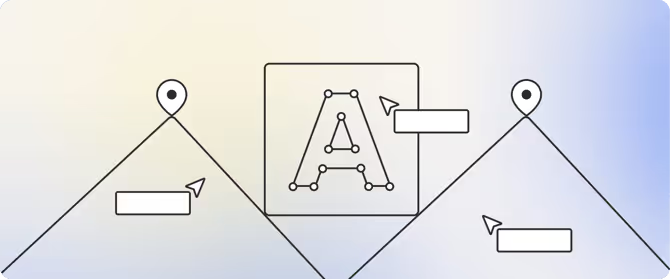Bridging the skills gap: A strategic approach to organizational success
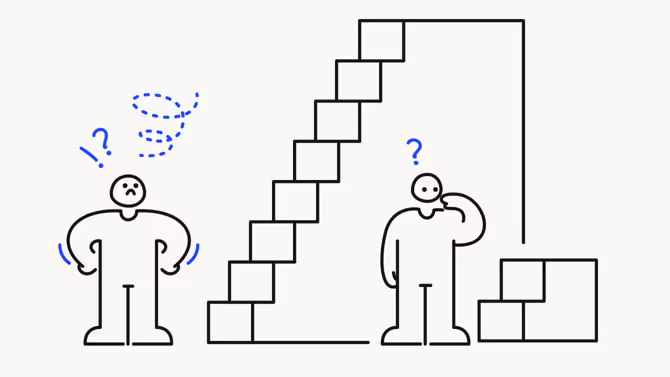
Empower your organization with the skills-based canvas.
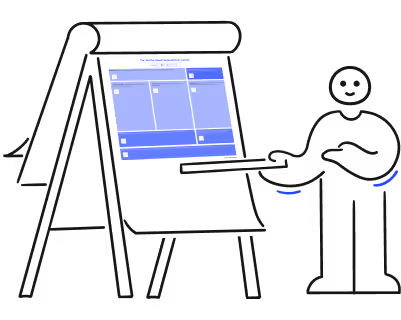
Skills gaps, the discrepancies between the skills employees possess and those required for organizational success, profoundly impact many facets of business operations. And guess what? Nearly 9 out of 10 executives and managers believe they are experiencing skill gaps within their teams or are expecting to face them soon.
Missing critical skills can threaten employee satisfaction and engagement, hinder productivity, and ultimately raise red flags around organizational performance and growth. The consequences of unaddressed skills gaps are far-reaching, underscoring the urgency for HR professionals to adopt a proactive and strategic approach to talent development.
Read on to learn how to better understand, measure, and effectively address skills gaps so that you can guide your organization toward success.
What are skills gaps?
Skills gaps are the voids between an employee’s skills and the skills required to meet organizational goals. They reveal a mismatch between what’s needed to do a job well and what someone is equipped to do.
Skill gaps can depend on the role and required skills, which can vary between soft and hard skills.
{highlight}For example, a skill gap for an IT professional might be related to a need for more expertise in a particular programming language like Python, JavaScript, or C++.{highlight}
While it’s easy to put the responsibility of a skill gap solely on the individual employee, the reality is not always as black and white.
Sometimes, skill gaps might be caused by a need for more clarity on a role by an employer, where a specific skill required to do the job well is only revealed later down the road. This is often the case for newly created roles or roles that evolve to meet new demands.
{highlight}For example, a marketing expert hired to handle social media accounts might find a skill gap when the company adopts a new platform.{highlight}
Skills gaps could also be encountered when an employee is aiming for a promotion or looking to make a lateral move in the company, but they aren’t meeting the skills requirements.
{highlight}An example would be an employee who lacks leadership skills vying for a more senior role.{highlight}
Encountering skill gaps is a normal part of managing teams and a natural part of the employee journey. But, if unattended, skill gaps can impact employee engagement, productivity, and innovation. Identifying these gaps is crucial for supporting employee development, managing team performance, and the overall health of your organization.
A ripple effect: The consequences of leaving skills gaps unaddressed
Quiet skill gaps, unnoticed and unaddressed, can become the silent disruptors across an organization. They impact employee engagement and morale, leading to decreased performance, high turnover rates, and even arrested organizational growth.
A slowdown in productivity and performance is often the first and most apparent sign of unaddressed skill gaps. If employees lack the right skills to complete specific tasks, these tasks will either take longer or not be done correctly. The impact of skill gaps isn't insular and often trickles over onto the rest of the team — where skilled team members take on more to compensate for their peers' lack. So, addressing one employee's skill gaps protects an entire team's health.
The truth is, no employee comes in to work to do a bad job. So, confidence and job satisfaction take a hit when skills don't align with what's needed to succeed, regardless of good intentions. Frustration, disappointment, or embarrassment can have a long-term effect on retention. Employees who don't believe they are the right fit and are not offered adequate support in fixing skill gaps eventually look for a new job they would be better suited for. If you notice higher turnover rates in your talent pool, losing gems with great potential too soon, unaddressed skills gaps might be a root cause.
Addressing skill gaps is a matter of immediate improvement and a strategic move for long-term business prosperity. Luckily, there are easy ways to do that.
Identifying and measuring skills gaps
Measuring skills gaps requires a multifaceted approach. It's not enough to check qualifications off a list; it requires a deep understanding of current capabilities versus future needs. Using a combination of skills assessments, data analytics, and employee feedback can provide a comprehensive view of where your organization stands and what steps you need to take.
Here are some methods to achieve this:
- Employee self-assessments: They encourage self-reflection and personal development planning. Despite their reliance on self-awareness, they are a straightforward and scalable way to begin identifying skills gaps.
- Supervisor evaluations: Supervisors closely understand their team members' performance and can provide valuable insights into their skills and areas for improvement. This method leverages existing relationships and observations within the workplace.
- 360-degree feedback: This method provides a holistic view of an employee's skills and performance from multiple sources. It's handy for identifying soft skills gaps and areas for improvement that might not be evident to supervisors or through self-assessment alone.
- Skill audits: Conducting skill audits for specific roles allows HR to map out the required skills for each position and identify gaps at an organizational level. This method is foundational for strategic planning in learning and development.
- Training and development records review: Reviewing past training activities can help identify skills gaps and how effective past training programs have been in addressing these gaps. This can inform future training initiatives and strategies.
- Job performance analysis: Analyzing job performance data can provide objective insights into where employees struggle and which areas require additional support or training. This method can help correlate performance issues with potential skills gaps.
These methods are widely used because they balance qualitative insights (e.g., 360-degree feedback and supervisor evaluations) and quantitative data (e.g., job performance analysis and training records review). They also promote a culture of continuous feedback and learning, crucial for employee development and organizational growth in today's dynamic work environment. Combining these methods can provide a comprehensive understanding of skills gaps, enabling targeted interventions that support both individual growth and organizational needs.
Yes, but is there an easier way?
Of course, leveraging software like Workleap Skills can help organizations move beyond manual, time-consuming processes to a more dynamic, data-driven approach. Workleap Skills is designed to streamline and enhance the process of identifying employee skills gaps and assist HR professionals and managers in this critical area.
Here's how it can help:
- Skills directory: Workleap Skills maintains a comprehensive inventory of skills required for various organizational roles. It pulls from employee profiles, allowing you to access everyone's skills, automatically identifying and visualizing the skills gap with any role.
- Employee self-assessments: Employees can conduct self-assessments using an easy drag-and-drop method, rating their proficiency in various skills related to their job roles. These assessments can be aggregated to highlight perceived skills gaps from the employees' perspectives.
- 360-degree feedback: Integrated with Workleap Officevibe, managers can gather feedback from checkpoint cycles, reporting, one-on-ones, and OKRs, enabling a holistic view of an employee’s skills and performance. This multi-source feedback can uncover gaps that might not be evident from self-assessments or manager evaluations alone.
- Learning and development integration: The Workleap Skills training feature makes it so that employees and managers can add training activities directly into growth plans, including content from external sources like web-based Learning Management Systems (LMS) or content platforms. Not only do employee growth plans identify skill gaps, but with the training feature, they can also give employees the tools they need to bridge the gap.
- Data analytics and reporting: Workleap Skills analyzes and reports on skills gaps across teams, departments, or the entire organization. This can help HR leaders and executives understand broader trends and make informed decisions about workforce development strategies.
- Career pathing and succession planning: By identifying skills gaps, Workleap Skills can also support employee career pathing, suggesting roles they might aspire to and the skills needed to achieve those roles. This can be linked with succession planning to ensure a pipeline of talent within the organization.
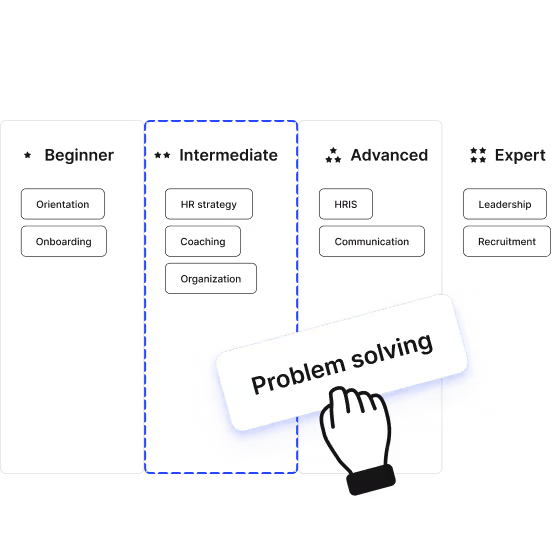
Strategies for addressing skills gaps
Addressing skills gaps is a continuous process. It involves creating a culture that prioritizes skill enhancement and collective growth.
Putting a focus on continuous learning and development
Continuous learning is not just a buzzword — it's a core aspect of addressing skills gaps for short and long-term success. Organizations need to cultivate a culture where the pursuit of improvement is part of day-to-day operations. This comes to life by providing access to learning initiatives that empower employees to acquire new skills and adapt to evolving job requirements.
Training for skill-building is one thing. But refresher courses to help employees keep their skills sharp over time, or upskilling programs that open up more internal career development opportunities to others, are a great way to promote continuous development within your company.
However, continuous improvement doesn’t only apply within the constraints of a structured program. Consider integrating learning initiatives into daily work routines. Whether through a quick team knowledge-sharing session during morning huddles or a weekly internal newsletter, learning becomes an easy habit to keep up and a shared pursuit.
Encouraging mentorship and collaboration
Mentorship and peer collaboration create an environment where knowledge flows seamlessly. They are vital components for skill enhancement and leverage the expertise of others to bridge gaps through shared experiences and mutual support.
Setting up a mentorship program allows employees to learn from more seasoned employees. This is a great way for skill-building outside of course training. Here, the gains are two-fold: Mentorees get to be exposed to the real-life experiences of professionals they aspire to, and mentors gain leadership and training skills.
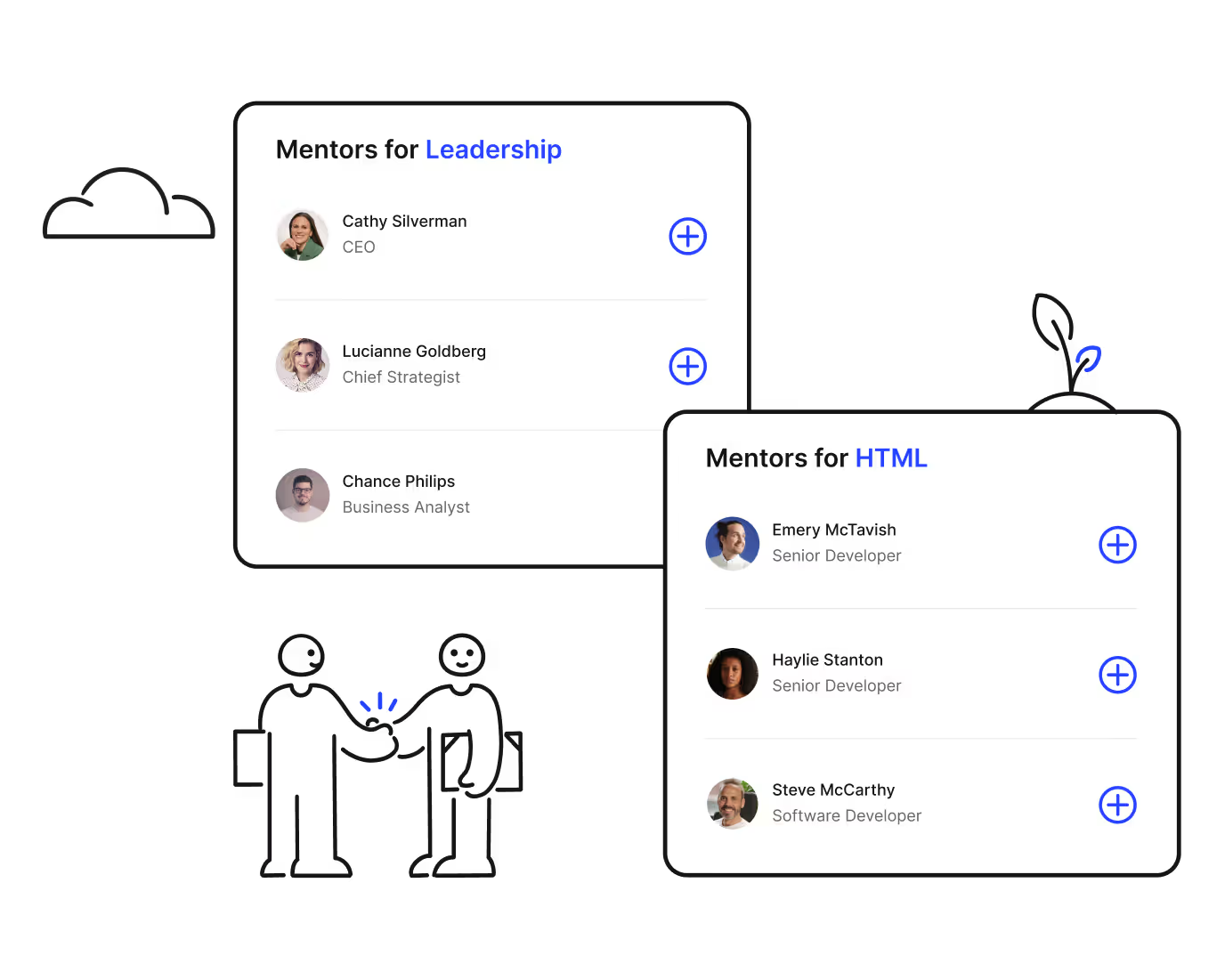
Cross-functional collaboration brings together diverse skills and expertise to achieve a shared goal. Encouraging teams from different departments to collaborate not only fosters a richer exchange of ideas but also ensures that everyone is exposed to a variety of skills, expanding their knowledge beyond their immediate responsibilities. To top it off, peer collaboration builds a culture of inclusivity and collective growth.
Tailoring career progression plans to each employee
Generic career plans fall short of supporting individual success, so personalizing career progression plans to each employee is essential. These plans serve as dynamic roadmaps, guiding each employee on their unique journey of skill development and career advancement to meet personal and professional goals.
The right plan is what makes the solution actionable. By identifying employees' unique skills, strengths, and professional aspirations, career progression plans can be crafted to address an employee’s skills gaps appropriately and realistically.
{emphasize}🚩 41% of employees leave their jobs because they lack career development opportunities. Learn how career progression plans can combat this.{emphasize}
Bridging the gap in real life: Amazon's skill-building strategy toward a successful future
Skill gaps are an expected part of managing and nurturing talent. If you're currently facing skill gaps within your team, don't worry — others have been there before and have turned things into a surprising opportunity.
You might be surprised to read that online retailer giant Amazon had to address a gigantic skill gap issue. The company faced over 100,000 future positions needing to be filled by 2025. Because succession planning of this magnitude can't be left to the last minute, Amazon started to invest in bridging the gap now rather than later. The company pledged to invest $700M in training and upskilling programs for their existing workers.
Shaping tomorrow's talent today with Workleap
The journey to bridging gaps isn't just about filling the voids. It's also about connecting the dots further to shape tomorrow's talent landscape better. With the right approach (and the right software) you're not only identifying and fixing current skill gaps but anticipating future ones.
Short of being a crystal ball, Workleap Skills is the next best thing to ensure a future-ready workforce. If you're ready to experience a better way to lead your team toward confidence and proficiency, book a demo with one of our product experts, who will show you how with Workleap Skills.
Monitor, support, and optimize your team's professional development.


%20(1).avif)


.avif)
.avif)





